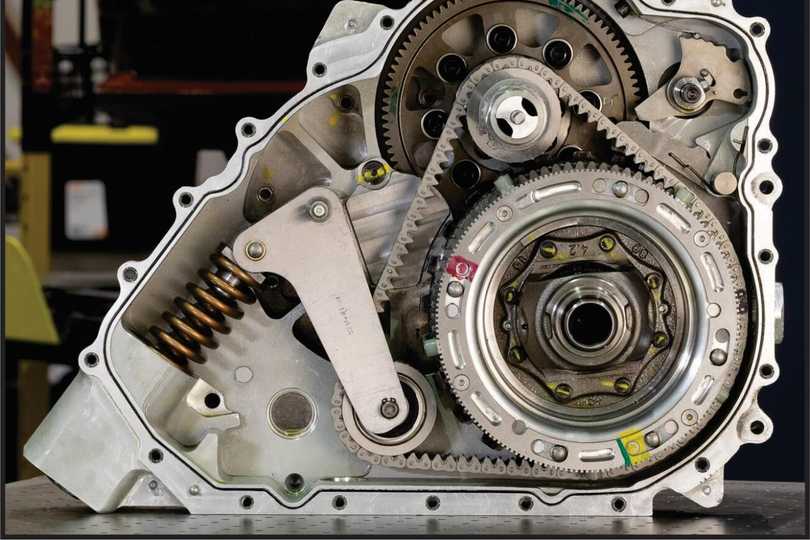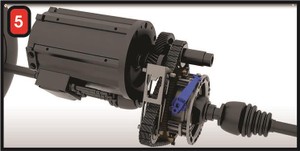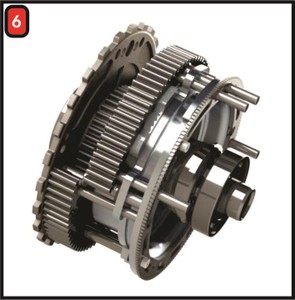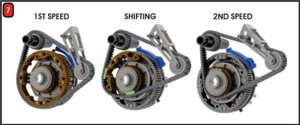A few years ago, I created an article in a trade magazine about a new innovative transmission called the Zero Shift. The design of this transmission was based on a bicycle part called a “derailleur” which would allow a multi-speed bicycle to seamlessly shift up and down through the gears, said Wayne Colonna of ATSG.
Zero Shift company has since expanded these transmissions into electric vehicles, motorcycles, see figure 1, and marine applications.
The unique feature of the Zero Shift transmission is the patented design that eliminates the need for synchronizers and instead uses dog clutches, figure 2.
This allows the transmission to shift without any rpm drop by using electronic actuators and an automated dry clutch which can be powered by air or hydraulics.
For example, when the transmission is in neutral, the first ring is engaged to prepare for forward movement while ring two takes up the backlash. Upshifts are made by ring two taking up forward movement while ring one takes up the backlash. In other words, this transmission design allows power on shifting because there is little load on the shifting components, see figure 3.
The dog-clutch “bullets” operate in sets of two opposing torque directions, figure 4. During a shift from one gear to another, the two bullet sets are both automatically engaged in the same direction as the torque that is being applied, eliminating that loss of engine speed that occurs in other types of transmissions. This increases fuel economy, because no fuel is wasted, the engine continues to drive the wheels of the vehicle during shifting.
Fast forward a few years and some electric vehicle engineers are realizing that the electric motors that power these vehicles are inefficient without some kind of transmissions behind them.
Electric motors produce torque in a vastly unique way. Because they can access the full current and voltage from the battery, electric motors can produce maximum torque at zero rpm and have a broad power band. Some electric motors can rev up to 10,000 rpm or more, but most are limited to a lower level to increase reliability. The high torque produced at zero rpm and the wide power band means that many EVs might only have one gear reduction between the electric motors and the wheels. For reverse, they run the electric motor backwards. The maximum speed in reverse is limited by software. This all sounds like a quite simple and efficient system.
However, Electric motors with a single gear are great for around town, and a quick getaway from the lights. But this set-up is not ideal for sustained highway speeds and towing, which can impact the one thing everyone with an EV worry about, battery range. An electric motor’s torque output drops off at higher rpm, as does its efficiency, which impacts the batteries available range. This is why there are companies creating transmissions to keep the motor at its most efficient rpm.
That brings us to a company called Inmotive that has created and patented a two-speed transmission call “Ingear” specifically for electric vehicle use. It is like the Zero Shift design in as much as it resembles a bicycle transmission and can easily be used for an electric motor architecture, figure 5.
Inmotive, a Canadian-based automotive supplier, has launched its patented Ingear two-speed transmission. Invented and designed for the next generation of electric vehicles, the Ingear features a simple and durable design that enables a more efficient powertrain, with extended range, at a lower cost. Typically, there are two reduction gears between the electric motor and the wheels, with the motor turning about nine times for each revolution of the wheels. The Ingear replaces the second reduction gear with a continuous chain drive and a morphing sprocket that resizes during a shift. The entire shift happens during a single revolution of the wheel.
To shift, an actuator directs sprocket segments into place during a single revolution of the wheels, figure 6, effectively increasing or decreasing the gear ratio. Ingear’s patented geometry keeps the motor and wheels coordinated, enabling continuous torque flow throughout the shifting process. Shifts can be completed in as little as 19 milliseconds.
Figure 7 illustrates how the Ingear transmission starts out in the low gear position by positioning the drive chain onto the larger diameter gear. Then illustrates the transition process as it begins the shift to second speed and finally by positioning the drive chain onto the smaller gear by moving the large gear segments which attain second speed.
Figure 8 shows how the Ingear transmission can be packaged into a transmission case for installation behind an electric motor. Another fact to realize is the driver has no manual control to shift gears in this transmission as I am sure will be the case as more of these type transmissions appear which will fit right into the autonomous vehicle category.
As the electric vehicle evolves, so will the transmissions of the future which means there will still be transmissions to repair for future generations of technicians. As more of these transmissions are introduced you can be sure ATSG will be there to bring this information to light.
Photos courtesy of Zero Shift and Inmotive










